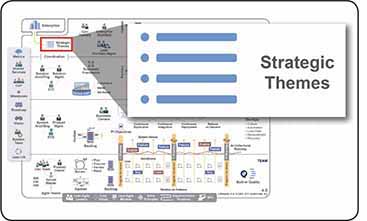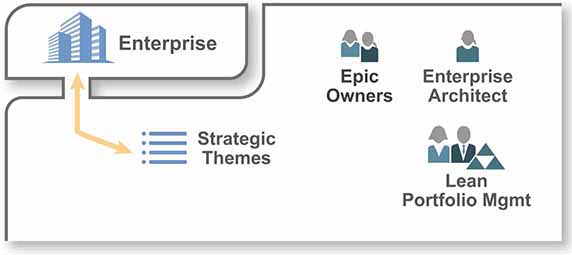

Innovation distinguishes between a leader and a follower.
—Steve Jobs
Strategic Themes are differentiating business objectives that connect a portfolio to the strategy of the Enterprise. They provide business context for decision-making and serve as inputs to the Vision, budget, and backlogs for the Portfolio, Large Solution, and Program Levels. The primary purpose of strategic themes is to drive portfolio innovation and differentiation.
Strategic themes don’t need to restate the obvious, as most elements of a portfolio vision are understood. That is, Portfolio stakeholders know quite well what the portfolio is for, and they establish and manage their mission and vision. Instead, strategic themes provide the enterprise with the differentiators needed to move from the current state to a more desirable, future state. They help drive innovation and competitive differentiation achievable only through effective portfolio Solutions.
Can you list ten things to get done in your portfolio that are important? When push comes to shove, what are the three (or five) most important of these items? Strategic themes provide the business objectives that highlight changes to the enterprise strategy affecting a particular solution portfolio. They are a significant communication mechanism between the enterprise and its solution portfolios (Figure 1).

Figure 1. Strategic themes connect a portfolio to the broader enterprise context
Strategic themes are an output of a collaborative process in which the enterprise’s executives and fiduciaries work with portfolio stakeholders to analyze a set of inputs before arriving at conclusions as illustrated in Figure 2.
Some examples of these themes follow:
Appeal to a younger demographic (online retailer)
Implement product and operational support for trading foreign exchange securities (securities company)
Standardize on three software platforms (large IT shop)
Lower warehouse costs (online retailer)
Establish single sign-on from portfolio applications to internal enterprise apps (independent software vendor)
Strategic themes are a vital tool for communicating strategy to the entire portfolio, providing a simple, memorable message that influences everyone involved in solution delivery.
Strategic themes are primary inputs to other portfolio elements (Figure 3). They affect the following aspects of the enterprise’s operations:
The value stream budgets
The content in the Program and Solution Backlogs
The ART and Solution Train vision and Roadmap
The Economic Framework
Strategic themes profoundly influence value stream budgets, which provide the investment and allocation of people needed to accomplish the strategic intent. Organizations should keep the following questions in mind when making those decisions:
Do the current investments in value streams reflect the changes to the existing business context?
Are we investing the appropriate amounts in new products and services? Are the capabilities of our current products and services sufficient or is more investment warranted? Are our maintenance and support activities sufficiently funded?
Which other adjustments are required based on the new themes?
Strategic themes provide decision-making filters in the Portfolio Kanban system that influence the portfolio backlog. Within this system, they have the following implications:
Impact the identification, success criteria, and prioritization of Epics in the funnel and backlog states
Warrant consideration and discussion in the Lean business case (see the Epic chapter)
May impact splitting and implementation of epics
Strategic themes influence the ART and Solution Train vision and roadmap and help determine the attributes of Weighted Shortest Job First (WSJF) prioritization for items in the Program and Solution Backlogs. Solution and program epics that flow from the portfolio, or arise locally, are also influenced by the current themes. Moreover, strategic themes provide vital conceptual alignment between the trains. Due to their importance, they are often presented by the Business Owners during Program Increment (PI) Planning.
Finally, because they can affect any major element of the pipeline—including development cycle time, product cost, product value, development expense, and risk—strategic themes may have a significant impact on the economic framework.
Identifying desired business outcomes for strategic themes can establish a context for assessing progress toward the strategic intent. However, many desirable measures of intent are trailing indicators. Measures of success, such as return on investment (ROI) and new markets penetrated, can take a long time to reach the desired levels.
Instead, the organization needs fast feedback from early indicators, many of which are not financial metrics. Lean organizations apply innovation accounting to address this challenge [1]. Innovation accounting is a thoughtful look at which early indicators are likely to produce the desired long-term results. It includes implementing the tooling, functionality, testing, or other mechanisms needed to collect those data.
In addition, certain criteria for success can be based on investment or activity. For example, an online retail store might want to reach a younger demographic. In this case, the success criteria could consist of a mix of investments, activities, and early indicators. A first learning Milestone might be to test the hypothesis of whether extending online capabilities to mobile platforms would appeal to the target audience. This could be measured easily with feedback from focus groups or analysis of mobile platform traffic data. From there, a second step might be to increase the budget for the mobile platform teams. To start trending the data, an epic Minimum Viable Product (MVP) could also be employed to capture the ages of users across all purchasing points.
Strategic theme outcome criteria provide indicators that allow the people managing the portfolio to understand the solutions involved, validate technical and business hypotheses, and, where necessary, pivot toward a better solution. The PI cadence offers an excellent timebox for experimenting with new approaches and gathering the feedback needed to show that investments in new strategic themes are likely to produce the desired long-term results.
LEARN MORE
[1] Ries, Eric. The Lean Startup: How Today’s Entrepreneurs Use Continuous Innovation to Create Radically Successful Businesses. Crown Business, 2011.